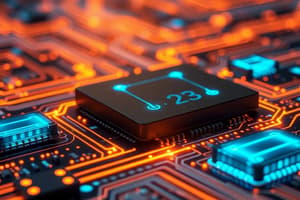Podcast
Questions and Answers
What is a key limitation of monolithic ICs?
What is a key limitation of monolithic ICs?
- Complex manufacturing process
- Large size
- Limited power capabilities (correct)
- High cost
How do thick-thin film ICs differ from monolithic ICs?
How do thick-thin film ICs differ from monolithic ICs?
- Use only active components
- Smaller in size but larger in power (correct)
- Larger in size but smaller in power
- Integrate all components on one chip
What type of components might be connected discretely in thick-thin film ICs?
What type of components might be connected discretely in thick-thin film ICs?
- Resistors and capacitors
- BJT and diodes (correct)
- Passive components
- Active components
What distinguishes hybrid ICs from monolithic and thick-thin film ICs?
What distinguishes hybrid ICs from monolithic and thick-thin film ICs?
How are bipolar ICs different from unipolar ICs based on active devices used?
How are bipolar ICs different from unipolar ICs based on active devices used?
How are bipolar ICs further classified based on the isolation technique used?
How are bipolar ICs further classified based on the isolation technique used?
What is the purpose of the virtual ground concept in opamp analysis with negative feedback?
What is the purpose of the virtual ground concept in opamp analysis with negative feedback?
In the context of opamps, how does real ground differ from virtual ground?
In the context of opamps, how does real ground differ from virtual ground?
When analyzing opamp circuits, under what condition is the concept of a virtual ground valid?
When analyzing opamp circuits, under what condition is the concept of a virtual ground valid?
How does a differential amplifier combine the functionality of inverting and non-inverting amplifiers?
How does a differential amplifier combine the functionality of inverting and non-inverting amplifiers?
What does grounding the inverting input terminal achieve in a differential amplifier circuit?
What does grounding the inverting input terminal achieve in a differential amplifier circuit?
How is the input signal V1 amplified in a differential amplifier when the non-inverting terminal is grounded?
How is the input signal V1 amplified in a differential amplifier when the non-inverting terminal is grounded?
What is the purpose of the photolithographic process in the context of semiconductor fabrication?
What is the purpose of the photolithographic process in the context of semiconductor fabrication?
What is the purpose of the photoresist layer in the photolithographic process?
What is the purpose of the photoresist layer in the photolithographic process?
What happens to the photoresist layer during the exposure process?
What happens to the photoresist layer during the exposure process?
What chemical is typically used for developing the photoresist layer after exposure?
What chemical is typically used for developing the photoresist layer after exposure?
What happens to the SiO2 layer that is not protected by the polymerized photoresist?
What happens to the SiO2 layer that is not protected by the polymerized photoresist?
How is the resist mask removed after the etching and diffusion processes?
How is the resist mask removed after the etching and diffusion processes?
What is the primary function of the input resistor (Ri) in an inverting amplifier circuit?
What is the primary function of the input resistor (Ri) in an inverting amplifier circuit?
What is meant by the term 'virtual ground' in the context of an inverting amplifier circuit?
What is meant by the term 'virtual ground' in the context of an inverting amplifier circuit?
Why is it said that the input current (Iin) cannot enter the op-amp in an inverting amplifier circuit?
Why is it said that the input current (Iin) cannot enter the op-amp in an inverting amplifier circuit?
What is the purpose of the feedback resistor (Rf) in an inverting amplifier circuit?
What is the purpose of the feedback resistor (Rf) in an inverting amplifier circuit?
In an inverting amplifier circuit, what is the relationship between the input voltage (Vin) and the output voltage (Vout)?
In an inverting amplifier circuit, what is the relationship between the input voltage (Vin) and the output voltage (Vout)?
What is the primary advantage of using an inverting amplifier configuration compared to a non-inverting amplifier configuration?
What is the primary advantage of using an inverting amplifier configuration compared to a non-inverting amplifier configuration?
In the simplified instrumentation amplifier design, what is the result of shorting the resistances labelled R1 and removing Rg?
In the simplified instrumentation amplifier design, what is the result of shorting the resistances labelled R1 and removing Rg?
What is the gain of the practical instrumentation amplifier circuit using the μA 741 op-amp?
What is the gain of the practical instrumentation amplifier circuit using the μA 741 op-amp?
How can the gain of the practical instrumentation amplifier circuit be made variable?
How can the gain of the practical instrumentation amplifier circuit be made variable?
Which op-amp IC is suggested as a good choice for a compact instrumentation amplifier circuit?
Which op-amp IC is suggested as a good choice for a compact instrumentation amplifier circuit?
What is the maximum supply voltage that can be used for the LM324 op-amp IC in the instrumentation amplifier circuit?
What is the maximum supply voltage that can be used for the LM324 op-amp IC in the instrumentation amplifier circuit?
What is the primary advantage of using an active filter over a passive filter?
What is the primary advantage of using an active filter over a passive filter?
Flashcards are hidden until you start studying




